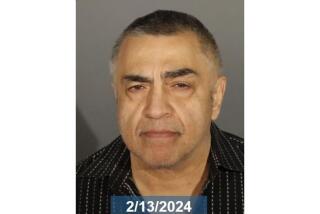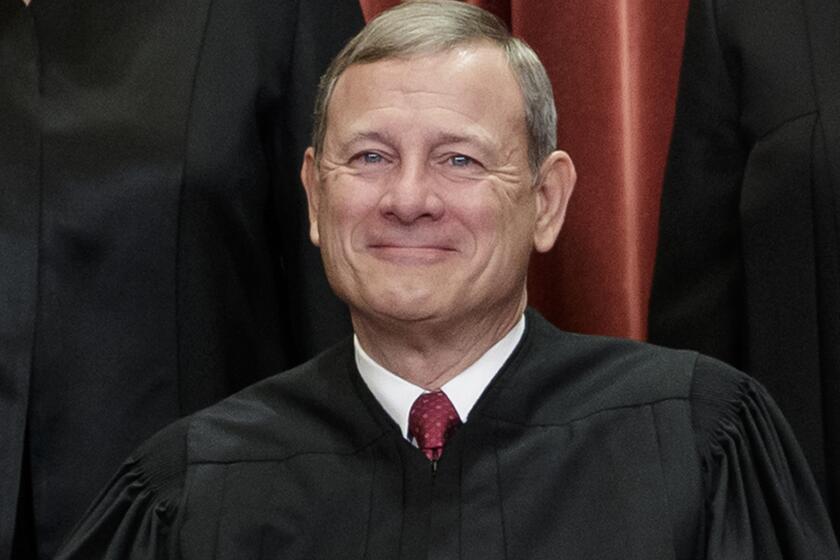U.S. Galled by Alleged Drug Lord’s Home
- Share via
TIJUANA — Some accused drug barons adopt disguises and lead shadowy existences in clandestine enclaves. Antonio Reynoso, however, lives out of the closet, in plain view of American officials who would like him extradited to the United States.
According to U.S. prosecutors, Reynoso was a mastermind of a conspiracy to ship cocaine through a fantastic “narco-tunnel” between Tijuana and San Diego. Yet he belongs to powerful business organizations, owns companies, and sends his children to private schools.
And to their profound annoyance, Justice Department officials say, Reynoso, 53, is putting the finishing touches on an ostentatious walled residence that backs right up to the U.S. border. If he wanted to, he could hit a tennis ball into San Diego County.
Reynoso’s mansion--and Mexico’s apparent inability to arrest him--has become a simmering symbol of U.S. doubts over the will of Baja California authorities to crack down on the Tijuana drug cartel.
U.S. officials can accept the difficulties of vanquishing the alleged cartel leaders, the Arellano Felix brothers. The reputed overlords of Mexico’s most vicious drug cartel--and their famed cordon of corrupt Baja judicial police--have allegedly shot their way out of more than one apprehension attempt.
Much harder for U.S. officials to swallow is the failure to move against Reynoso.
“It doesn’t make us very happy,” a Justice Department attorney said. “[The Reynosos have] too much money, too many political connections.”
Just the sight of the palatial Reynoso compound frays U.S. patience.
Encircled by a forbidding wall that ascends 35 feet, chateau Reynoso rises like a ship over San Diego County, not far from a binational gulch called Smuggler’s Canyon. With its turret, glass pool atrium and a dazzling green roof worthy of Oz, it is so conspicuous that Border Patrol agents sometimes point it out to visitors.
U.S. law enforcement officers note its fortress architecture and its protected position at the end of a narrow cul-de-sac. So close to the United States, they complain, yet so far from a San Diego courtroom.
“I wish we could just tunnel back and grab him,” a Justice Department attorney said.
The visit by President Clinton to Mexico last week renewed the hopes of some U.S. prosecutors for progress in the Reynoso affair.
Last summer, U.S. officials asked Mexico City authorities to issue a provisional arrest warrant for Reynoso. Once he is caught, Justice Department officials say, they would begin the laborious diplomatic paperwork to extradite him to face U.S. cocaine conspiracy charges.
Since then, Reynoso’s name has appeared on lists of traffickers given to Mexican authorities by U.S. Atty. Gen. Janet Reno. But no discernible action has been taken. U.S. officials have no indications that Reynoso is even a wanted man in Mexico. A spokeswoman for the federal attorney general’s office in Tijuana, Diana Ortiz, said she was not aware of any arrest warrant for Reynoso, though warrants are sometimes kept sealed.
The fall of the House of Reynoso began in 1993 with the seizure of a canned chili pepper shipment and the gangland murder of a Guadalajara cardinal.
The chili pepper cans, nabbed by Mexican police in picturesque Tecate, contained seven tons of cocaine and were guaranteed by Reynoso, U.S. prosecutors said. The canned cocaine was destined for shipment through a notorious narco-tunnel commissioned by accused drug lord Joaquin “Chapo” Guzman, said Assistant U.S. Atty. Cynthia Bashant in San Diego.
A month later, the Guadalajara cardinal was gunned down in what Tijuana cartel leaders portrayed as a horribly botched attempt to attack Guzman, their deadly rival. In the ensuing sweeps, Mexican federal agents stumbled across a fantastic, unfinished 1,416-foot underground passage between Tijuana and San Diego.
Dubbed the “Taj Mahal of tunnels,” the passage was 60 feet deep, reinforced by concrete and cooled by ventilation. It ended 120 feet shy of a warehouse being built for a Reynoso company, Tia Anita, that U.S. authorities said was its destination. U.S. agents say the miscalculation was caused by an erroneous county map.
In 1995, U.S. prosecutors named Antonio Reynoso and two of his brothers, Jose and Jesus, in an indictment of 22 alleged members of a vast ring accused of transporting cocaine from Mexico to Los Angeles, Chicago and New Jersey in Lear jets, soapboxes, boilers and canned vegetables.
In September, Jose Reynoso, 65, of Rowland Heights pleaded guilty to conspiring to use the tunnel to smuggle drugs and admitted buying the $1.1-million lot in Otay Mesa where the passage’s exit was to be located, Bashant said.
Antonio and Jesus Reynoso face charges of conspiracy to import and to possess cocaine with intent to distribute, as well as money laundering, said Bashant, the lead prosecutor on the case.
Had it not been for their downfall, the Reynoso manse might have been a crown jewel of their $30-million-a-year Los Angeles food importing empire, Reynoso Bros. The company ranked 13th in a 1992 survey of minority-owned businesses in Los Angeles County. The Reynoso case did little to assuage the concerns of those who fear that legal commerce under the North American Free Trade Agreement could be used to mask drug trafficking.
The Reynosos’ social cachet in Tijuana survived the indictment.
“He has a certain reputation, yet he belongs to polite society,” said Roberto Hernandez Alcaraz, head of arrests for the Tijuana state judicial police. “The man who has money enjoys the greatest privileges. Money gives you fictitious power, if not moral authority.”
But the Reynosos fared less well after an expose in the Mexico City Reforma daily and a follow-up in the award-winning Tijuana weekly, Zeta.
“It has come as a surprise to the people of Tijuana to know they have harbored one more family of drug traffickers, a very powerful family with a large business empire,” Zeta wrote in its Jan. 31 issue. “The question is: How many more families are there in Mexico like the Reynosos? These families are honorable, prosperous business people one day; drug traffickers the next.”
After years of seeing the Reynosos at church, the grocery store and their children’s private schools, the news came as a shock to some.
“Many people here defended them. They said how can that be? They’ve been members of this community for many years,” said a local housewife, who once ran a PTA with the spouses of Antonio and Jesus Reynoso.
Others, like the chic wife of a prominent Tijuana citizen, said her family never dreamed of socializing chez Reynoso, even though they are neighbors.
“Here, everyone knows what they do. Everyone knows how they made their money,” she said.
Neighbors of the Reynoso palace-in-progress tell tales of Jacuzzis in every bathroom and a foyer overlooking an enormous pool copied from the Mirage in Las Vegas. They portray it as the glitzy backdrop for a man who fuses the aesthetic sensibility of “Dynasty” with the compulsive shadiness of a “Miami Vice” bete noir.
“That house is like, wow, like living in Las Vegas,” a neighbor said.
Few have actually been inside. Workmen said the house is still not done and is unoccupied. It is listed, along with one of their longtime residences nearby, as one of Reynoso’s official addresses.
Two years ago, when construction was in the early stages, neighbors went over to complain about a fetid odor emanating from the Reynoso enclave. It was so horribly pungent that they thought someone had died in the yard, one neighbor said.
When they knocked on the gate, they were met by Antonio Reynoso himself, dressed in an immaculate white suit, the neighbor said. He told them that his workers were spreading cattle and chicken manure on the lot.
“We told him he was contaminating the air. He yelled at us and told us that we were ignoramuses, that he was just fertilizing the soil,” the neighbor recalled.
Efforts to speak to Antonio Reynoso and his wife were unsuccessful. A relative said he was vacationing with friends in Guatemala. A business associate said he may wait out his notoriety elsewhere. Workmen from a Reynoso company did not invite a reporter past the steel front gate of the villa.
To U.S. prosecutors, the house symbolizes the shameless audacity of a man who has continued to flourish in spite of the U.S. charges against him.
Although the indictment triggered a landslide of binational bankruptcies and foreclosures, Antonio and Jesus have hung on to more than a few border properties, some registered in their wives’ names or in trusts.
U.S. agents say Antonio even managed to somersault into the camp of the Arellano Felix brothers, the archenemies of his jailed ally, Joaquin Guzman--a rapprochement reportedly cemented by a strategic interfamily marriage.
U.S. authorities do not feel the same sense of urgency about extraditing his brother, Jesus, another longtime Tijuana resident. For one thing, he is rumored to be in the hospital with a heart condition.
For another, they say, Jesus is not building a house right under their noses.
“He’s not the one with the house down there. He’s not the one thumbing his nose at us,” a Justice Department attorney said.
More to Read
Sign up for Essential California
The most important California stories and recommendations in your inbox every morning.
You may occasionally receive promotional content from the Los Angeles Times.










